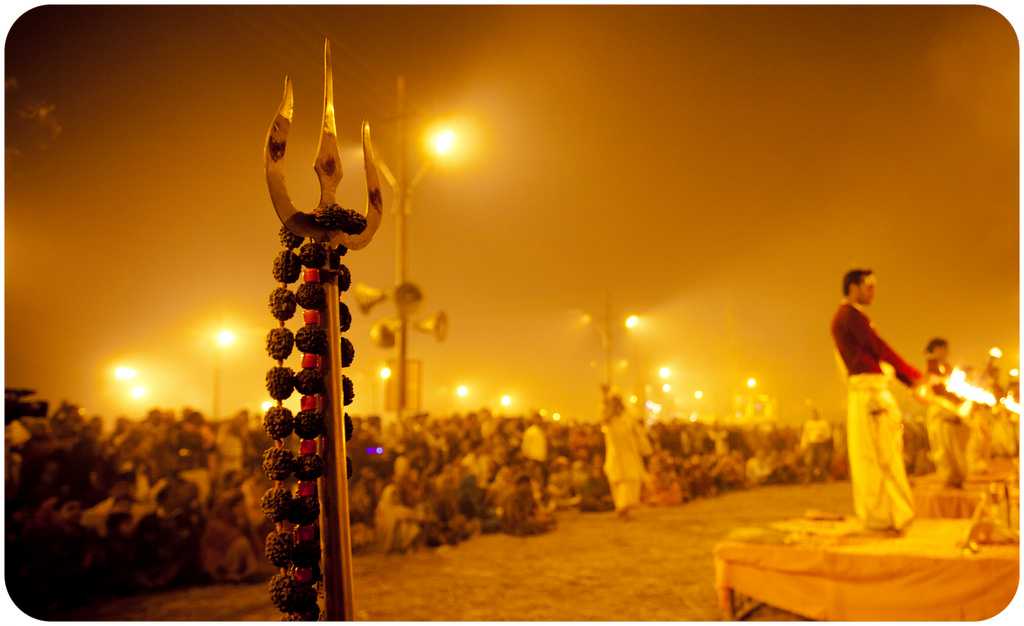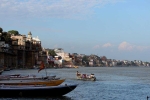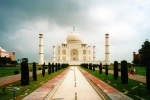"Prayaga- The city of offerings"
Allahabad Tourism
A few kilometres away from Varanasi, Allahabad is reminiscent of all that is spiritual and sacred in Hinduism. The largest city in Uttar Pradesh, Allahabad is famous for being the meeting point of three rivers - the Ganga, the Yamuna, and the Saraswati. Built on the site of the ancient town of Prayag, Allahabad has, since time immemorial, held the largest Hindu gathering on the banks of the Sangam' the Maha Kumbh Mela. While Allahabad is often passed over for more travel-friendly cities, there is a lot to Allahabad besides just its religion. The places oozes heritage, history, and stories galore, and once you visit the place, you will definitely have seen Allahabad differently for having travelled to and through it.
Allahabad is most famous for being home to the Triveni Sangam ? the spot where the three holy rivers meet and become one. One of the top places to visit in Allahabad if you?re spiritually inclined (and even if you?re not because this place deserves a visit), Triveni Sangam is a place bustling with tourists and locals all year round. The Maha Kumbh Mela is a religious occasion that is held here every twelve years and is attended by millions of pilgrims from all across the globe.
Allahabad is more than just its religion though, and the Khusro Bagh is probably the town?s most appealing surprise element. Named after Khusro Mirza, the son of Mughal Emperor Jahangir, the tombs of Khusro Bagh, as well as its wall art and stone carvings, clearly reflect the architecture of the Mughal period. The Allahabad Fort is another monument of historical significance and is heritage site recognized by the UNESCO. Built during the reign of Akbar, this fort is also a fine example of the curation and craftsmanship of the Mughal era.
Other popular places to visit in Allahabad include the Anand Bhavan, the All Saints Cathedral, the Chandra Shekhar Azad Park,
What's Great?
Very well connected by road, rail and air. One of the foremost religious sites in India. Excellent for a family vacation.
What's not so Great?
Summers can get very hot. Can get crowded during the tourist season and the months of Kumbh Mela. Some places are not very clean.
For Whom
Perfect for family vacation, those interested in religious tourism, photographers and cultural connoisseurs who want to experience the life in Allahabad. This places also sees a lot of foreigners who want to witness the majesty of the Ganga.
Ganga - The Soul of India
The Ganga flows down from the Himalayas and meanders through almost all of North India before slowing down near Allahabad and meeting with the Yamuna that follows a similar trajectory slightly north of Ganga. This place where two real and one mythical river (Saraswati) meet is called the 'Triveni Sangam' and is one of the holiest sites for Hindus. These rivers have now become part of the lives of people of Allahabad.
The peaceful Ghats, lazy sunsets and daily aartis at the riverbanks are some of the most beautiful spectacles the city has to offer. There are many temples, forts and monuments belonging to all time periods built along the banks of the Ganga and this is a testament to the undying spirit and the immense importance the river has in Indian life.
The Heart of the Hindi Culture
Allahabad has been referred to as Prayag in many ancient scriptures like the Vedas, Mahabharat and Ramayana and is believed to be the second-oldest city in India. It has for long been the centre of literary, scholastic and spiritual activity and is a cultural hub in North India. Famed for its sweet and pure Hindi, this city has given the country many great writers and poets.
Over the years, the culture of the town has embraced its Hindu, Muslim and Christian rulers wholeheartedly and this confluence of history is reflected in the diverse architectural styles seen in the city. Ancient temples stand beside Mughal forts and British gardens as citizens today equally belong to all three.
Kumbh Mela
The Kumbh mela in Allahabad is the greatest confluence of people on earth - and by a huge magnitude. Kumbh melas are held in four cities in India - Allahabad, Haridwar, Nasik and Ujjain, but the one in Allahabad is way bigger than anywhere else, and bigger than anything you could imagine. To give you an idea of the scale of the event - an estimated 120 million (12 cr) people visited the 2013 Kumbh Mela which was held over an area of atleast 10kms x 4kms.
The Kumbh Mela is mainly a religious aggregation - but for tourists, there is a lot to see and do. Just walking around the mela, sitting on the banks of the river and taking a dip in Sangam is an experience in itself. You can attend one of the hundreds ofashramsand listen to the sermons, or you can check out the street food which is available in abundance throughout the mela, or just be amazed by the sheer scale and size of the human gathering. If you want to get a feel of authentic, rural India - this is one of the most incredible events to do that.
The last Kumbh mela was held in 2013, which means the next big one would be held in 2025. However, if you can't wait till then, you could plan to visit during the 2019ardh-kumbh(semi-Kumbh) mela - which is pretty big in scale itself. Otherwise, the Magh mela which is held every year is something that you can visit - although you should multiply the scale by 10 to get an idea of what the real Kumbh mela looks like.
History of Allahabad
Allahabad?s name has been mentioned quite a few times in the Purans, the Ramayana and the Mahabharata. The Hindu mythology states that Lord Bramha chose a land on Earth to perform a Yajna at the beginning of creation. This place was known as Prayag. One can also find references to the city of Allahabad in the works of Huien Tsang, the Chinese chronicler. Allahabad?s British history started in the year 1801 when the Nawab of Oudh surrendered it to the British which was later used for military purposes by the British. The city of Allahabad has a great significance in the Sepoy Mutiny of 1857. After this, the city was merged with Punjab. Later, the capital of Northwest Provinces in India was shifted to Allahabad. This culturally rich city has always been under the influence of various tribes who have tried to conquer the city at various points in time. The Marathas, The Mughals and the British have also tried to leave their mark on the land at some time or other.
Itinerary
Day 1: Arrive in Allahabad by bus, train or air. Proceed to the hotel to relax and shed the travel fatigue. After lunch, visit the Hanuman Mandir, one of the most famous temples in the city. In the late afternoon, head to the Triveni Sangam - the most popular tourist spot and also one of the holiest sites for Hindus. You and also stay a little longer to witness the grand Ganga Aarti on Ganga Ghat but be prepared for a hoard of people to arrive as this is a very popular activity among tourists and devout locals. At night, you can enjoy the city vistas and perhaps try some local food in one of the many street markets famous for fried snacks and sweets.
Day 2: Leave early to visit the Allahabad Fort built by Akbar in 1583. Though only a small part of this fort is open to civilians and the rest is used by the army, it is one of the most beautiful buildings in Allahabad. The haloed Akshaya Vat (immortal banyan tree) is also located within the premises of the fort. After lunch, head to Anand Bhavan, the ancestral home of the Nehru-Gandhi family that was built by Motilal Nehru. The Jawahar Planetarium is located inside the complex and is worth a visit. Anand Bhavan has now been converted into a museum depicting the life and times of the Nehru-Gandhi family.
Day 3: Leave for the All Saint's Cathedral also known as Patthar Girija in the morning. This cathedral invites people of all faiths who want to feel close to God. Visit the Allahabad Museum just before lunch to get a glimpse of the rich history of this region. In the evening, head to Madan Mohan Malviya (Minto) Park, where the East India company transferred power to the British monarch, thus making India a colony of Britain. Proceed to departure point by bus, train or air.
Restaurants and Local Food in Allahabad
Street foods in Allahabad are very popular among the locals and tourists alike. A lot of shops in the old city area (mainly Chowk and Katra) are famous for their variety of street food. It is a foodie?s paradise as there are varieties of chaats, kebabs and sweets that can be found in its quirky eateries.Loknath is a very narrow and crowded lane in Chowk area which is very popular with street food lovers - you would find everything from chaat tokachoritokhasta/dum alootolassitohalwahere - to name a few. One of the most popular shops is the Hari namkeen which is famous for its unique samosas. One can expect to get a taste of Mughal cuisine as well as Awadhi cuisine. Some of the most famous eateries are Eat On Masala Restaurant, which serves finger-licking biryani and kebabs, and Netaram Kachori Sabji and Jalebi, which is known for its kachoris and jalebis prepared in desi ghee. For a sweet tooth, Heera Halwai is the best place to go and taste the delicious Gari ki Barfi.
View 7 Restaurants in Allahabad >>
Oct-Maris the best time to visit Allahabad
October to March are the best months to visit Allahabad. Magh Mela typically happens in the month of mid-January - early March (according to Hindu Calendar), and this is the time when thousands of people flock to the town to take a dip in holy Sangam. However, the Maha Kumbh happens only once in 12 years during the same months, and should not be missed. Though Allahabad is accessible throughout the year and tourists sites are also always open, summer temperatures can get uncomfortably high, and it is best to avoid this time. During the monsoon, the Ghats may not be accessible, and there are restrictions on people bathing in the river so this time too is not ideal.
Weather in Allahabad
Loading...
Allahabad in Summer (April - June)
The summer months are extremely hot in Allahabad and should be avoided if possible. Temperature goes as high as up to 45 degrees Celcius during the day, and since almost all of the sightseeing in Allahabad is outdoors, this wouldn't be a good time to visit at all.
Allahabad in Monsoon (July - September)
Allahabad doesn't see a lot of rain, but the temperature is still quite warm and the flow of the rivers becomes fast and unpredictable. There is also some flooding during some years, and you might not be able to visit the Sangam during this time, making it a little pointless to visit during the rains.
Allahabad in Winter (October - March)
These are the best months to visit Allahabad. The temperature is pleasant throughout the day, and the flow of water in the rivers is steady and calm which is great for boating or taking a dip in the water. You would also see quite a few migratory birds hovering near the Sangam area during these months. The famous guavas of Allahabad are only available during the winter - these are true to the hype and extremely delicious.
Monthly Weather in Allahabad
Month
Avg. Minimum (°C)
Avg. Maximum (°C)
January
6
22
February
12
28
March
16
33
April
24
41
May
27
42
June
29
40
July
26
33
August
27
34
September
26
35
October
22
36
November
14
29
December
10
25
Events in Allahabad
Kumbh Mela
15th January - 4th Marc
The Kumbh held at Prayag has a special significance as this marks the rise of the sun which symbolises wisdom. Creation of the universe is supposed to have originated here, and it is considered the centre of the earth. In the 2013 Allahabad Kumbh, more than 120 million people visited which is the largest human gathering in the world.
Comments on Allahabad
Post Your Comment


 Triveni Sangam
Triveni Sangam Kumbh Mela 2019
Kumbh Mela 2019 Allahabad Planetarium
Allahabad Planetarium Khusro Bagh
Khusro Bagh Varanasi
Varanasi Vindhyachal
Vindhyachal Sarnath
Sarnath Chitrakoot
Chitrakoot Agra
Agra Ayodhya
Ayodhya